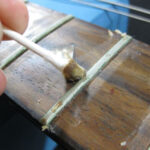For left-handed musicians, the journey to playing guitar hasn’t always been straightforward. Imagine the frustration of a young Paul McCartney, forced to reverse the strings on a right-handed acoustic just to play! Thankfully, the music world has become far more inclusive, offering a wide array of instruments, including the increasingly popular Acoustic Electric Left Handed Guitar. These guitars combine the rich, resonant tones of acoustic instruments with the versatility of electric amplification, perfectly tailored for left-handed players. But before you jump in and buy the first one you see, there are several key considerations to ensure you choose the best instrument for your musical journey.
One of the first things to consider is the musical genre you intend to explore. Different guitar styles are naturally suited to different sounds. For instance, if you are drawn to the warm, intimate sounds of fingerstyle or blues, a smaller-bodied guitar like a parlor guitar can be an excellent choice. Parlor guitars are known for their focused tone and comfortable size, making them ideal for players who appreciate nuanced sound and ease of handling. Conversely, if you’re aiming for a bolder, more resonant sound for genres like rock, folk, or country, you might want to consider a larger body style.
Alt text: Close-up of acoustic guitar neck and frets, highlighting playability for left-handed musicians.
Size and shape are crucial elements in your selection process. For musicians with a larger frame or those seeking a powerful, booming sound, the dreadnought guitar stands out as a classic choice. Dreadnoughts are renowned for their full, resonant tone and projection, making them incredibly versatile across numerous genres. They are a popular choice for strumming and flatpicking, delivering a robust sound that fills a room. However, if you have a smaller body type, or are selecting a guitar for a younger player, guitars with a cutaway design offer enhanced playability. The cutaway allows for easier access to the higher frets, making playing solos and more complex passages significantly more comfortable. Similarly, the guitar’s neck profile is paramount for comfort. A neck that fits comfortably in your hand will make playing for extended periods much more enjoyable and less fatiguing. Generally, smaller guitars tend to have slimmer necks, while larger guitars often feature wider necks.
Alt text: Illustration showcasing various acoustic guitar body shapes including dreadnought, parlor, and cutaway, emphasizing options for left-handed players.
Finally, the tonewoods used in constructing an acoustic electric left handed guitar significantly impact its sound. Different woods possess unique tonal characteristics. Sitka spruce, for example, is a popular top wood known for its bright, clear tone and broad dynamic range, making it versatile for many playing styles. Cedar, on the other hand, offers a warmer, mellower tone, often favored for fingerstyle playing and gentler genres. Mahogany is prized for its rich, warm, and resonant sound, often used for backs and sides and sometimes as a top wood for a different tonal flavor. The quality of the wood also plays a role, influencing the instrument’s resonance and overall sound quality. Finding the right balance between wood type and quality is key to achieving your desired tone.
Considering these factors—genre, size and shape, neck profile, and tonewoods—will significantly simplify the process of choosing from the vast selection of acoustic electric left handed guitars available today. Whether you envision yourself performing on stage, recording in a studio, or simply enjoying music around a campfire, the right acoustic electric left handed guitar will empower you to play your way, comfortably and expressively. With instruments now designed specifically for left-handed players, the joy of making music is more accessible than ever.

